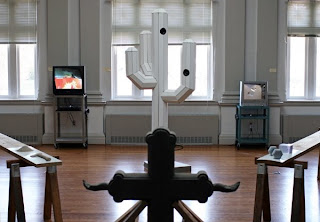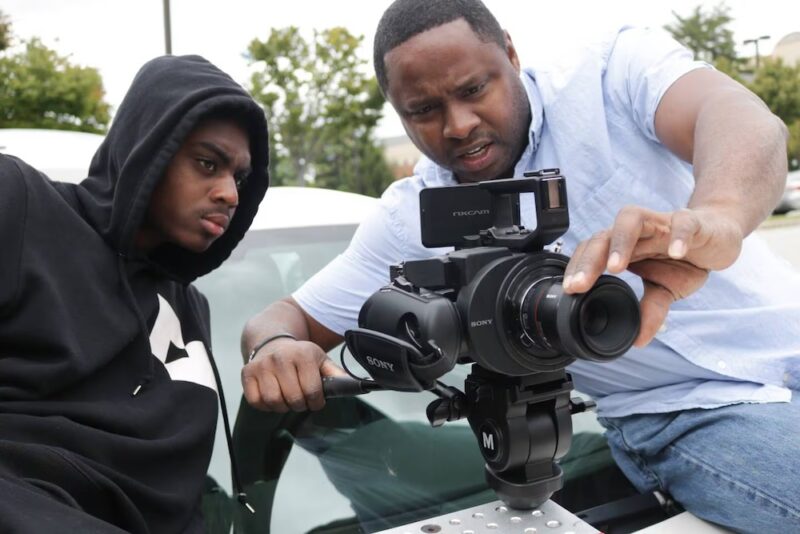 Christopher LaVoie’s newest exhibit in Westminster, MD, is a picture of modernity’s cut-and-run sentiment mixed with the sentimentality of memories. It is as much a tribute to LaVoie’s past and future—his generation and its outcome—as it is to the materials that the artist manipulates. Upon first walking into the show, one cannot help but notice the symmetry of the works’ alignment. The placement of each work is as thoughtful and ordered as LaVoie’s life perspective. His works do not speak of a rending of a previous life the present one, but instead speak of a reconciliation of these extremities. This includes time, use, and ultimately personality.
Christopher LaVoie’s newest exhibit in Westminster, MD, is a picture of modernity’s cut-and-run sentiment mixed with the sentimentality of memories. It is as much a tribute to LaVoie’s past and future—his generation and its outcome—as it is to the materials that the artist manipulates. Upon first walking into the show, one cannot help but notice the symmetry of the works’ alignment. The placement of each work is as thoughtful and ordered as LaVoie’s life perspective. His works do not speak of a rending of a previous life the present one, but instead speak of a reconciliation of these extremities. This includes time, use, and ultimately personality.
 With such a personal exhibit, one must regard each work and the reaction to such in a personal manner—it is only fair, as works of identity are meant to impress upon the viewer’s perspectives and emotions directly. In this vein, what most surprised me about the artist’s work was not, I am shocked to say, its oddity of innovation. One would think that a snowball’s livelihood as a brick would inspire the greatest response over anything else. Even a dumbbell made by Radiohead CDs could find some applause for its creative regeneration.
With such a personal exhibit, one must regard each work and the reaction to such in a personal manner—it is only fair, as works of identity are meant to impress upon the viewer’s perspectives and emotions directly. In this vein, what most surprised me about the artist’s work was not, I am shocked to say, its oddity of innovation. One would think that a snowball’s livelihood as a brick would inspire the greatest response over anything else. Even a dumbbell made by Radiohead CDs could find some applause for its creative regeneration.


However, what most baffled me—and impressed me—was the overall lack of a negative tone within the pieces. It is natural to assume that viewing the ashes of a Reebok next to their original state would imply a bitterness to change. After a study of the entire exhibit, however, it is a surety that LaVoie meant no such acrimony. The vanishing point, overlooked at first by the viewer, is an enormous stone grave marker, carved skillfully in the shape of an aged cross with the markings “27 YRS” running down its middle. Two hands flank its horizontal beam while it is supported by wooden construction beams. This was an enjoyable thought piece to complement the entire series. The viewer wonders at the implications of a gravestone, yet inscrutably returns to the feeling of a peaceful nostalgia over a crushed memory.
 The then “graveyard” of memory stands on wooden sawhorses, emphasizing the transience of its objects and their placement in LaVoie’s life. Even when ground to a pulp, the new forms that each old object takes on inspires a new aesthetic use and even more tantalizing comparison between the old and new. In a sense, the artist is saying that the memories in their old forms could not have survived innovation, technology, or the future itself—they are better left to be seen in a place where viewers can pay their respects to what was once a few of the greatest parts of a man’s life.
The then “graveyard” of memory stands on wooden sawhorses, emphasizing the transience of its objects and their placement in LaVoie’s life. Even when ground to a pulp, the new forms that each old object takes on inspires a new aesthetic use and even more tantalizing comparison between the old and new. In a sense, the artist is saying that the memories in their old forms could not have survived innovation, technology, or the future itself—they are better left to be seen in a place where viewers can pay their respects to what was once a few of the greatest parts of a man’s life.
 Mixed between the memories are simple reflections on innovation. A hatchet formed out of sod presents LaVoie’s message in even greater focus. Memory aside, it shows the dirt ground in a pile combined with an image of the new, the useful, the powerful hatchet formed of its counterpart. I found the exhibit to be incredibly cohesive in this aspect. It pulls time into a before and after picture frame, lacing the message with a blend of nostalgia and tranquil hope.
Mixed between the memories are simple reflections on innovation. A hatchet formed out of sod presents LaVoie’s message in even greater focus. Memory aside, it shows the dirt ground in a pile combined with an image of the new, the useful, the powerful hatchet formed of its counterpart. I found the exhibit to be incredibly cohesive in this aspect. It pulls time into a before and after picture frame, lacing the message with a blend of nostalgia and tranquil hope.
 What could possibly be considered as the centerpiece of the exhibit—not just for its size and attraction but for its actual location—is a life-sized cactus constructed from siding. In place of spikes are four imbedded speakers playing the Beach Boy’s Good Vibrations at random times of the night. While the meaning is still unclear, it seems that the “house” cactus is merely an amalgamation of innovation, of past memories, and of future movement.
What could possibly be considered as the centerpiece of the exhibit—not just for its size and attraction but for its actual location—is a life-sized cactus constructed from siding. In place of spikes are four imbedded speakers playing the Beach Boy’s Good Vibrations at random times of the night. While the meaning is still unclear, it seems that the “house” cactus is merely an amalgamation of innovation, of past memories, and of future movement.
 The writer, Emily Biondo, is an undergraduate art student at McDaniel College in Steven Pearson’s class.
The writer, Emily Biondo, is an undergraduate art student at McDaniel College in Steven Pearson’s class.



